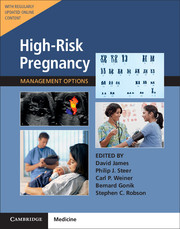Book contents
- Frontmatter
- Contents
- List of Contributors
- Preface
- Section 1 Prepregnancy Problems
- Section 2 Early Prenatal Problems
- Section 3 Late Prenatal – Fetal Problems
- 9 Prenatal Fetal Surveillance
- 10 Fetal Growth Disorders
- 11 Disorders of Amniotic Fluid
- 12 Fetal Hemolytic Disease
- 13 Fetal Thrombocytopenia
- 14 Fetal Cardiac Arrhythmias
- 15 Fetal Cardiac Abnormalities
- 16 Fetal Craniospinal and Facial Abnormalities
- 17 Fetal Genitourinary Abnormalities
- 18 Fetal Gastrointestinal and Abdominal Abnormalities
- 19 Fetal Skeletal Abnormalities
- 20 Fetal Tumors
- 21 Fetal Hydrops
- 22 Fetal Death
- Section 4 Problems Associated with Infection
- Section 5 Late Pregnancy – Maternal Problems
- Section 6 Late Prenatal – Obstetric Problems
- Section 7 Postnatal Problems
- Section 8 Normal Values
- Index
14 - Fetal Cardiac Arrhythmias
from Section 3 - Late Prenatal – Fetal Problems
- Frontmatter
- Contents
- List of Contributors
- Preface
- Section 1 Prepregnancy Problems
- Section 2 Early Prenatal Problems
- Section 3 Late Prenatal – Fetal Problems
- 9 Prenatal Fetal Surveillance
- 10 Fetal Growth Disorders
- 11 Disorders of Amniotic Fluid
- 12 Fetal Hemolytic Disease
- 13 Fetal Thrombocytopenia
- 14 Fetal Cardiac Arrhythmias
- 15 Fetal Cardiac Abnormalities
- 16 Fetal Craniospinal and Facial Abnormalities
- 17 Fetal Genitourinary Abnormalities
- 18 Fetal Gastrointestinal and Abdominal Abnormalities
- 19 Fetal Skeletal Abnormalities
- 20 Fetal Tumors
- 21 Fetal Hydrops
- 22 Fetal Death
- Section 4 Problems Associated with Infection
- Section 5 Late Pregnancy – Maternal Problems
- Section 6 Late Prenatal – Obstetric Problems
- Section 7 Postnatal Problems
- Section 8 Normal Values
- Index
Summary
Introduction
The myocardium first starts to contract about 26 days after conception as a consequence of the rhythmical electrical depolarization of pacemaker-precursor cells. Cardiac arrhythmias are commonly encountered later in development and have been reported in about 2% of all pregnancies. With increasing use of antenatal screening, arrhythmias are more likely to be encountered, usually as a random pick-up. While the majority of them are benign (mostly atrial ectopic beats), some are associated with significant morbidity and mortality. For the latter group appropriate antenatal diagnosis may improve outcome by proper pre- and postnatal therapy.
After birth, diagnosis, classification and management are primarily guided by the electrocardiogram (ECG), which provides details on the electric circuits of the heart. However, this technique cannot be readily applied antenatally, and the diagnosis is based predominantly on mechanical function.
Fetal arrhythmias are usually classified into one of the following groups:
• irregular rhythm
• bradyarrhythmia (< 110 beats per minute [bpm])
• tachyarrhythmia (> 180 bpm)
Normal Physiology and Development of Arrhythmia
A basic understanding of the normal cardiac (electro-)physiology is a prerequisite for proper diagnosis and management. Normally, electrical impulses are generated and conducted in specialized cells that form part of the conduction system. (1) Action potentials are rhythmically generated by synchronized transmembrane ion currents within the cells of the sinoatrial (SA) node, resulting in spontaneous depolarization and repolarization. Through gap junctions, the electrical current is then propagated (2) across the atria via (3) the atrioventricular (AV) node to (4) the His bundle, (5) the Purkinje fibers, and finally to (6) the ventricles, resulting in coordinated contraction and relaxation of the myocardium. At the cellular level, each mechanical contraction is initiated by a cardiomyocyte action potential (AP) as shown in Figure 14.1. Schematically, the interior of the myocyte is negatively charged during resting potential (phase 4). With excitation (e.g., from advancing current from the SA node), the cell becomes depolarized, causing opening of fast Na+ channels and a steep upstroke of the membrane potential (phase 0).
- Type
- Chapter
- Information
- High-Risk Pregnancy: Management OptionsFive-Year Institutional Subscription with Online Updates, pp. 322 - 340Publisher: Cambridge University PressFirst published in: 2017



